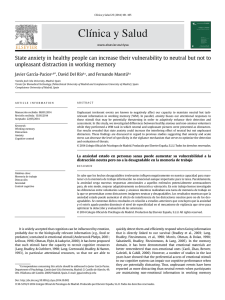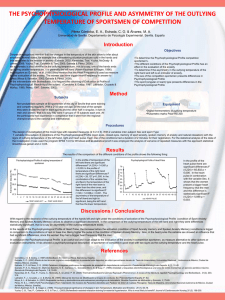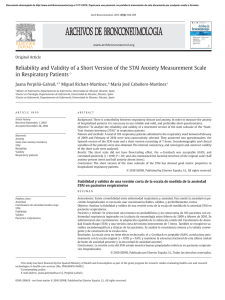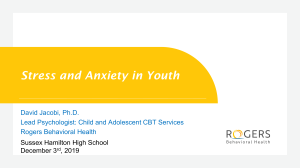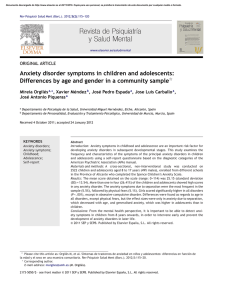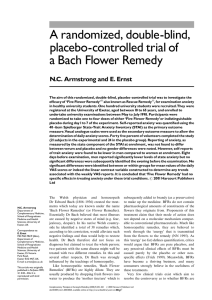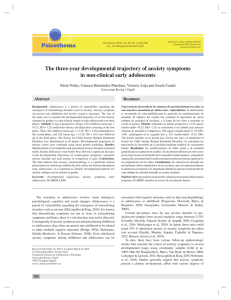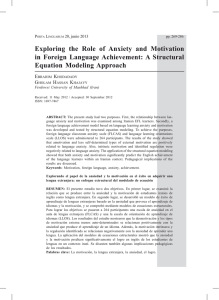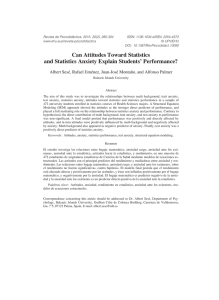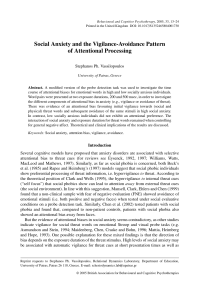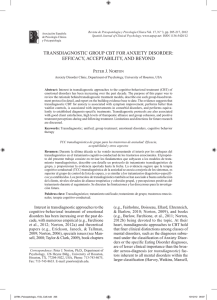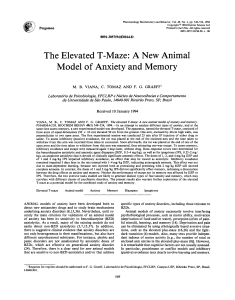Identification of degrees of anxiety in children with
Anuncio
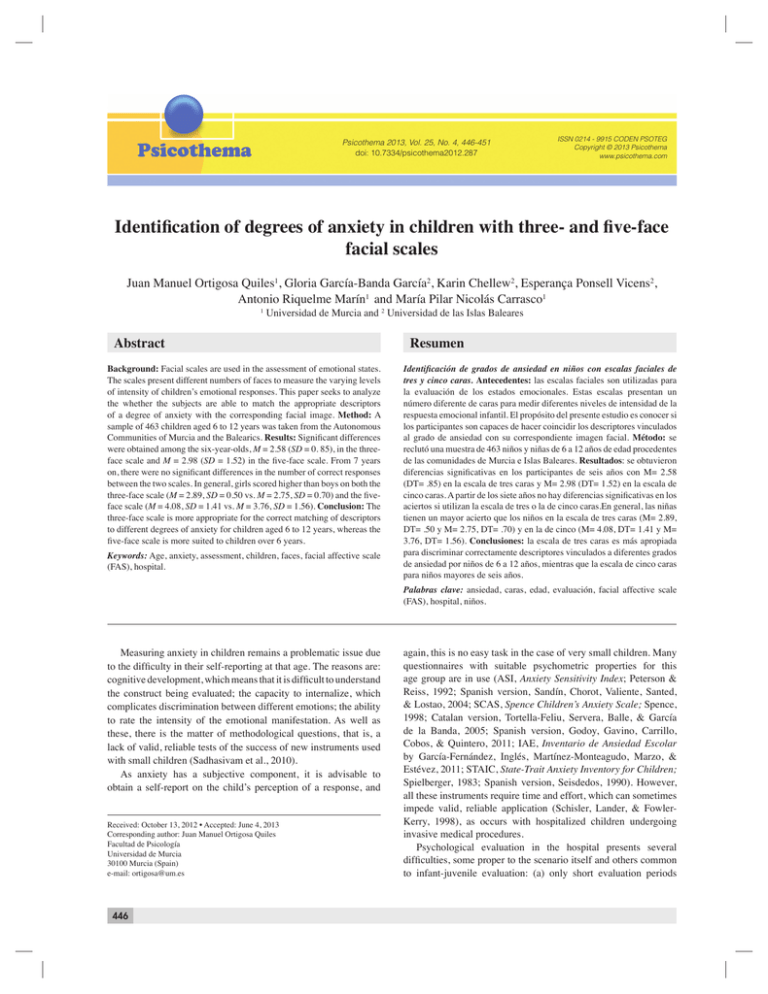
Juan Manuel Ortigosa Quiles, Gloria García-Banda García, Karin Chellew, Esperança Ponsell Vicens, Antonio Riquelme Marín and María Pilar Nicolás Carrasco Psicothema 2013, Vol. 25, No. 4, 446-451 doi: 10.7334/psicothema2012.287 ISSN 0214 - 9915 CODEN PSOTEG Copyright © 2013 Psicothema www.psicothema.com Identification of degrees of anxiety in children with three- and five-face facial scales Juan Manuel Ortigosa Quiles1, Gloria García-Banda García2, Karin Chellew2, Esperança Ponsell Vicens2, Antonio Riquelme Marín1 and María Pilar Nicolás Carrasco1 1 Universidad de Murcia and 2 Universidad de las Islas Baleares Abstract Background: Facial scales are used in the assessment of emotional states. The scales present different numbers of faces to measure the varying levels of intensity of children’s emotional responses. This paper seeks to analyze the whether the subjects are able to match the appropriate descriptors of a degree of anxiety with the corresponding facial image. Method: A sample of 463 children aged 6 to 12 years was taken from the Autonomous Communities of Murcia and the Balearics. Results: Significant differences were obtained among the six-year-olds, M = 2.58 (SD = 0. 85), in the threeface scale and M = 2.98 (SD = 1.52) in the five-face scale. From 7 years on, there were no significant differences in the number of correct responses between the two scales. In general, girls scored higher than boys on both the three-face scale (M = 2.89, SD = 0.50 vs. M = 2.75, SD = 0.70) and the fiveface scale (M = 4.08, SD = 1.41 vs. M = 3.76, SD = 1.56). Conclusion: The three-face scale is more appropriate for the correct matching of descriptors to different degrees of anxiety for children aged 6 to 12 years, whereas the five-face scale is more suited to children over 6 years. Keywords: Age, anxiety, assessment, children, faces, facial affective scale (FAS), hospital. Resumen Identificación de grados de ansiedad en niños con escalas faciales de tres y cinco caras. Antecedentes: las escalas faciales son utilizadas para la evaluación de los estados emocionales. Estas escalas presentan un número diferente de caras para medir diferentes niveles de intensidad de la respuesta emocional infantil. El propósito del presente estudio es conocer si los participantes son capaces de hacer coincidir los descriptores vinculados al grado de ansiedad con su correspondiente imagen facial. Método: se reclutó una muestra de 463 niños y niñas de 6 a 12 años de edad procedentes de las comunidades de Murcia e Islas Baleares. Resultados: se obtuvieron diferencias significativas en los participantes de seis años con M= 2.58 (DT= .85) en la escala de tres caras y M= 2.98 (DT= 1.52) en la escala de cinco caras. A partir de los siete años no hay diferencias significativas en los aciertos si utilizan la escala de tres o la de cinco caras.En general, las niñas tienen un mayor acierto que los niños en la escala de tres caras (M= 2.89, DT= .50 y M= 2.75, DT= .70) y en la de cinco (M= 4.08, DT= 1.41 y M= 3.76, DT= 1.56). Conclusiones: la escala de tres caras es más apropiada para discriminar correctamente descriptores vinculados a diferentes grados de ansiedad por niños de 6 a 12 años, mientras que la escala de cinco caras para niños mayores de seis años. Palabras clave: ansiedad, caras, edad, evaluación, facial affective scale (FAS), hospital, niños. Measuring anxiety in children remains a problematic issue due to the difficulty in their self-reporting at that age. The reasons are: cognitive development, which means that it is difficult to understand the construct being evaluated; the capacity to internalize, which complicates discrimination between different emotions; the ability to rate the intensity of the emotional manifestation. As well as these, there is the matter of methodological questions, that is, a lack of valid, reliable tests of the success of new instruments used with small children (Sadhasivam et al., 2010). As anxiety has a subjective component, it is advisable to obtain a self-report on the child’s perception of a response, and Received: October 13, 2012 • Accepted: June 4, 2013 Corresponding author: Juan Manuel Ortigosa Quiles Facultad de Psicología Universidad de Murcia 30100 Murcia (Spain) e-mail: [email protected] 446 again, this is no easy task in the case of very small children. Many questionnaires with suitable psychometric properties for this age group are in use (ASI, Anxiety Sensitivity Index; Peterson & Reiss, 1992; Spanish version, Sandín, Chorot, Valiente, Santed, & Lostao, 2004; SCAS, Spence Children’s Anxiety Scale; Spence, 1998; Catalan version, Tortella-Feliu, Servera, Balle, & García de la Banda, 2005; Spanish version, Godoy, Gavino, Carrillo, Cobos, & Quintero, 2011; IAE, Inventario de Ansiedad Escolar by García-Fernández, Inglés, Martínez-Monteagudo, Marzo, & Estévez, 2011; STAIC, State-Trait Anxiety Inventory for Children; Spielberger, 1983; Spanish version, Seisdedos, 1990). However, all these instruments require time and effort, which can sometimes impede valid, reliable application (Schisler, Lander, & FowlerKerry, 1998), as occurs with hospitalized children undergoing invasive medical procedures. Psychological evaluation in the hospital presents several difficulties, some proper to the scenario itself and others common to infant-juvenile evaluation: (a) only short evaluation periods Identification of degrees of anxiety in children with three- and five-face facial scales are available, (b) a developmental focus has to be adhered to when selecting the evaluation tool, (c) specific evaluation tests are required, and (d) the evaluation tests must be attractive to the child (Quiles & Pedroche, 2000). To this, we would add the child’s previous familiarity with the test. One psychological evaluation tool for use in hospital environments is the visual analog scale in numerical format (Bringuier et al., 2009; Crandall, Lammers, Senders, Saavedra, & Braun, 2007), or in graphic form with colored or facial scales (Abu-Saad & Holzemer, 1981; Hicks, von Baeyer, Spafford, van Korlaar, & Goodenough, 2001; McGrath et al., 1996; Meisel et al., 2010; Miró, Huguet, Nieto, Paredes, & Baos, 2005; Quiles, vander Hofstadt, & Quiles, 2004; Stinson, Kavanagh, Yamada, Gill, & Stevens, 2006). Facial scales start from common conceptual base but they present differences in format according to the number of faces included (from 3 to 9 faces), the elements of expression (forehead, eyebrows, eyelids, number of tears and mouth) and the orientation (horizontal or vertical) (Salas, Gabaldón, Mayoral, & Amayra, 2002). According to Méndez (1999), the use of a scale of drawings, materials or gesture helps small or disabled children to score an emotional state numerically. These scales, also known as single item scales, usually include instructions for the child to choose from a series of graded responses using adverbs of intensity, frequency, duration or probability which allow the child to value the magnitude of his or her emotional state. The evaluator then translates the child’s response to a numerical scale in order to give a score to the choice. Whereas there has been a number of works on validation and application of facial scales that measure the intensity of pain in various medical conditions (Chambers, Hardial, Craig, Court, & Montgomery, 2005; Goodenough et al., 1997; Tomlinson, von Baeyer, Stinson, & Sung, 2010), the same does not hold for measures of anxiety response in the face of medical procedures, even though this is one of the most described responses and among the most used in empirical studies (Bringuier et al., 2009; Buchanan & Niven, 2002; Kain, Mayes, O’Connor, & Ciccheti, 1996; Teichman, Ben Rafael, & Lerman, 1986; Tiedeman & Clatworthy, 1990). The Facial Affective Scale (FAS) was designed by McGrath to evaluate not just the pain intensity, but also the discomfort associated with pain in children (McGrath et al., 1996). Most studies have used this scale to evaluate pain in this population (Jensen, 2012; St-Laurent-Gagnon, Bernard-Bonnin, & Villenueve, 1999). Others use the scale to measure both aspects (Page et al., 2012; Perrot, Goodenough, & Champion, 2004). Recent studies, however, have used the FAS to assess only the affective component, understood as both negative/positive affect (Affect; Nilsson, Kokinsky, Nilsson, Sidenvall, & Enskar, 2009), and emotional distress (Distress; Connelly & Neville, 2010). Thus, we believe that the FAS visual scale could be used to evaluate the degree of child anxiety quickly and reliably. The main aim here is to adapt and validate a facial scale to measure anxiety in children undergoing medical procedures, and the first work with the multiphase study is presented. This study seeks to determine whether participants are capable of matching the descriptors associated to the degree of anxiety with the corresponding facial image, according to the number of faces presented (three or five), to the quantifiers used (none, a little, some, etc.), and to the age and sex of the participants. Method Participants A sample was taken of 463 school children, 241 boys (52%) and 222 girls (48%) with an average age of 8.82 years (SD = 1.81) from the Region of Murcia and the Balearic Islands, in three state schools and in one semi-subsidized school, in urban areas, the majority of middle class social and economic means (73.3% upper middle class and 26.7% lower middle class). The sample is non-probabilistic (incidental), as the schools chosen were those that had previously expressed interest in collaborating with research groups. Exclusion criteria included difficulties in completing the tasks due to language or cognitive disability. Instruments The facial scale used in this study was developed by McGrath et al. (1996) and is known as the Facial Affective Scale (FAS). The FAS comprises nine drawings of children’s faces whose expressions vary according to the level of discomfort (Figure 1). Although this scale has been mainly be used to measure pain intensity in children in hospitals it was originally designed to measure their affective discomfort too (associated emotional distress). The original order of the nine faces ranges from a smiling face to a frowning one with eyes closed, wailing and mouth turned down (which shows the highest level of discomfort). Three and five of these faces were chosen for our study. These fulfilled criteria of equidistant progression in the expressive elements of eyebrows, eyelids, tears and smile (so respecting the degree of emotional intensity) (Figure 2). Figure 1. Original nine-face FAS No anxiety A little anxiety No anxiety Some anxiety Some anxiety High anxiety Very high anxiety Very high anxiety Figure 2. Modified FAS using 5 and 3 faces and their corresponding descriptors 447 Juan Manuel Ortigosa Quiles, Gloria García-Banda García, Karin Chellew, Esperança Ponsell Vicens, Antonio Riquelme Marín and María Pilar Nicolás Carrasco Three and five quantifiers were then selected on the basis of a progressive grading from lower to higher anxiety. The descriptors chosen for the three-face scale were no anxiety, some anxiety, high anxiety, whereas for the five-face scale they were no anxiety, a little anxiety, some anxiety, high anxiety and very high anxiety. Two sheets were prepared for classroom application of the task. On each, there was the three- or five-face scale, and at the lower part of the sheet there was a box with the categories of the different degrees of anxiety, randomly distributed. Procedure After obtaining permission from the school directors and parents, the tasks were performed with the children during tutorial hours. A protocol was established for the presentation of the sheets and the following instructions were given for the three-face scale: “We have three faces here. We’d like you to choose the word in the box below that you think best describes each face, and write it below that face”. For further clarification the instruction was rephrased: “Decide which of the faces looks the most or least anxious, and use one of the words below to describe them”. The children were then allowed a short time to ask questions and if they asked about the meaning of the word anxiety, we explained to all the students that it meant “being nervous” or “being worried.” After the first task had been performed, we moved on to the five-face scale. The following instructions were given: “Now we have five faces! Again just like before, we’d like you to choose the word in the box below that you think best describes each face, and write it below that face.” Counterbalancing (randomized presentation of sheets) was used to control for any bias in the order of presentation. Using feedback from the teachers, those pupils who had difficulties in performing the task correctly were allowed to complete them but were not included in the database and therefore were not taken into account in the statistical analysis. of presentation of the tasks did not significantly affect performance according to the results of the Student T tests (3 faces: p = .367; 5 faces: p = .118). Since the Levene and Kolgomorov-Smirov tests returned statistically significant results, the Kruskal-Wallis test was applied to study the effect of the variable age on the number of correct matchings in both scales. There were differences both in the 3-face, χ2 (6) = 13.904, p = .031, and the five-face scale, χ2 (6) = 38.623, p<.001. Six-year olds scored 86% success in the three –face scale and 57% in the five-face scale. As age affected the performance outcome in both scales, the Games-Howell test for multiple comparisons was applied to ascertain the direction of this effect, and a statistically significant difference was found between 6-year olds and the other age groups for the 5-face scale (see Tables 2 and 3). Nevertheless, it should be noted that whereas the Kruskal-Wallis test was significant for 3 faces, the post-hoc comparisons with the Games-Howell test revealed no significant differences between 6 year olds and the other ages for this scale. In the case of the variable sex, the results were analyzed using the nonparametric Mann-Whitney U-test, and statistical significance appeared for the 3-faces scale (Z = -2.362, p = .018) whereas there was marginal significance for that of 5 faces (Z = Table 1 Sample distribution by age and sex (%) Sex Age Data analysis First, the Chi-square test was used to analyze the composition of the sample in terms of age and sex. It was then tested that the assumptions of homogeneity of variances and normality were fulfilled using the Levene and Kolgomorov-Smirov tests, respectively, as follows: (a) if fulfilled, a two-factor ANOVA was run with age and sex as independent variables and task performance as the dependent variable 3 and 5 face scale); (b) if the ANOVA assumptions were not fulfilled, the non parametric Kruskal-Wallis H and the Mann-Whitney U-tests were applied for age and sex, respectively. If the age factor was statistically significant, the post-hoc multiple comparison of means test was used which, depending on whether or not the assumption of homogeneity of variances was fulfilled, was the Tukey or Games-Howell T-test, respectively. The program used for the analysis was the Statistical Package for the Social Sciences (SPSS), version 18. Results Distribution by sex throughout the age groups was homogeneous according to the Chi square test calculated on the corresponding contingency table, χ2 (6) = 4.227, p = .300 (see Table 1). The order 448 Total Boy Girl 6 34 (14.1%) 26 (11.7%) 60 (13.0%) 7 37 (15.4%) 33 (14.9%) 70 (15.1%) 8 40 (16.6%) 36 (16.2%) 76 (16.4%) 9 32 (13.3%) 45 (20.3%) 77 (16.6%) 10 37 (15.4%) 41 (18.5%) 78 (16.8%) 11 44 (18.3%) 28 (12.6%) 72 (15.6%) 12 17 (7.1%) 13 (5.9%) 30 (6.5%) Total 241 (100.0%) 222 (100.0%) 463 (100.0%) Table 2 Means and standard deviations of correct responses in the three and five-face scales, according to age and sex 3 faces Age Boy Girl M (SD) M (SD) 6 2.53 (.86) 7 8 5 faces Total Boy Girl Total M (SD) M (SD) M (SD) M (SD) 2.65 (.85) 2.58 (.85) 2.76 (1.62) 3.27 (1.37) 2.98 (1.52) 2.62 (.89) 3.00 (.00) 2.80 (.67) 3.78 (1.57) 4.12 (1.05) 3.94 (1.35) 2.68 (.80) 2.94 (.33) 2.80 (.63) 3.55 (1.77) 4.25 (1.25) 3.88 (1.58) 9 2.94 (.35) 2.84 (.60) 2.88 (.51) 4.06 (1.48) 4.38 (1.05) 4.25 (1.25) 10 2.72 (.72) 2.90 (.44) 2.83 (.59) 3.71 (1.53) 3.78 (1.35) 3.79 (1.43) 11 2.91 (.42) 2.89 (.57) 2.90 (.48) 4.27 (1.15) 4.43 (0.92) 4.33 (1.06) 12 2.88 (.49) 3.00 (.00) 2.93 (.37) 4.12 (1.27) 4.23 (1.01) 4.17 (1.15) Total 2.75 (.70) 2.89 (.50) 2.82 (.62) 3.76 (1.56) 4.08 (1.21) 3.91 (1.41) Identification of degrees of anxiety in children with three- and five-face facial scales -1.774, p = .076). In general, girls were more successful than boys in both scales. Specifically, girls scored higher in the 3-face scale at all ages except 9 and 11 years. In contrast, girls performed better than boys in the 5-face scale at all ages except 10 years. A descriptive analysis of the success rate for both facial scales reveals how boys and girls behave when correctly placing each face in its appropriate category. It was observed that 6-year olds were less effective in grading no anxiety (80% correct) and high anxiety (81% correct) in the 3-face scale. In the 5-face scale, children of all ages were clearly less effective at grading some and high, especially the 6-year olds (31.67% and 48.34% correct, respectively). Table 3 Games-Howell Test for the variable age. Multiple comparisons between sixyear-olds and the other ages for the three and five- face scales 3 faces 5 faces Age (years) Means differences Sig. Means differences Sig. 7 -.220 .687 -.960 .005 8 -.220 .639 -.900 .017 9 -.300 .205 -1.260 .000 10 -.250 .455 -.810 .029 11 -.320 .142 -1.350 .000 12 -.350 .128 -1.180 .002 Discussion The aim of this study was to ascertain whether age influences children’s effectiveness when using facial scales to measure degrees of anxiety. A task was planned whose aim was to study whether children from 6 to 12 years are able to identify degrees of anxiety and correctly associate them to the faces representing them. The tasked assumes that the child has a cognitive development that enables correct use of the Piaget components to measure magnitudes (comparison, classification, correspondence and seriation). Moreover, the child will have sufficient linguistic development to be able to assess and correctly qualify different degrees of emotional response using quantifiers. Finally, the child should be sufficiently developed psychologically to have enough introspective capacity to be able to identify an emotion and measure it correctly (Besenski, Forsyth, & von Bayer, 2007). Our results indicate that children aged 6 to 12 years can be equally effective in identifying and classifying different degrees of anxiety on a 3-item facial scale, as the results present no clear differences between ages. In contrast, when the task is extended to five faces, 6-year olds are significantly less effective than the other schoolchildren, so this tool is recommended for use by children of 7 years or more. The original 9-face FAS was built for use with children of five and over. We know that children under 7 have difficulties understanding the FAS, even when it comprises only five faces (Chellew, Pol, Pérez, Picardo, & Matas, 2011). The original scale would, therefore, be of little use to measure pain or psychological anxiety in children under six (Meisel et al., 2010). Our results also show that, according to the percentage of correct responses, children have greater difficulties in distinguishing between some and high anxiety, especially 6-year olds, and tend to be better at classifying the degrees none, some and very high anxiety. Chambers & Johnston (2002) found that children aged 5-6 years tend to give more extreme responses the more options they are offered. A high percentage of the children answered correctly for the extreme categories (none, high, very high) on both the 3-face and the 5-face scales. Indeed, when the degree high anxiety is placed at the end of the 3-face scale, the child scores better than when it is placed in a middle position in the 5-face scale. The tendency for 6-year olds towards extreme categories has two readings. On the one hand, when they respond using a 5-face scale, they bias their response as if they were using a 3-face scale, thus scoring higher at the two extremes of the scale (none and very high) and at the mid-point (some). On the other hand, it is observed that with the 5-face scale, there is a decrease in the number of correct responses at all ages in the categories some and high, which suggests there may be some confusion between the terms. Indeed, in some cases, the children interchanged the two. Differences due to sex were also found with girls, who were, in general, more accurate in the tasks. The influence of this variable is a controversial issue, because the finding is in contrast in terms of ordering and seriation to those of other studies (BinghamNewman & Hooper, 1974; Shih & von Baeyer, 1994). However, when we refer to recognition of emotional expression, girls and adolescents are more skillful (Herba & Phillips, 2004; Proverbio, Matarazzo, Brignone, del Zotto, & Zani, 2007). A recent study (Hoffman, Kessler, Eppel, Rukavina, & Traue, 2010) reported that men and women performed equally in their recognition of faces with intense expressions, although women performed better when the changes were more subtle. It may be that the ease with which women recognize facial emotions is determined by biologicalevolutionary or even cultural components. Our study has several limitations which advise viewing the result with some prudence. First, the composition of the sample needs to include more 12-year olds. Second, the nonprobabilistic sampling procedure limits any generalization of the results to the population as a whole. Third, the use of faces from a scale that was originally conceived to measure children’s perception of pain may not be very appropriate for measuring anxiety. Finally, the choice of quantifiers used for the degrees of anxiety may lead to some confusion in some categories. Given the results and the limitations of the study, future research should focus on: (a) extending the lower age range to determine up to what age the use of 3-face scales is viable; (b) determining what descriptors are appropriate for grading anxiety; (c) ascertaining which facial expression, placement of faces and descriptors are most suitable to avoid extreme responses when measuring anxiety in situations that need to be administered quickly and with reliable measures. In conclusion, our findings confirm the usefulness of the facial scale comprising five faces and quantifiers for measuring various degrees of anxiety from seven years on. At lower ages, a response bias was detected towards choosing extremes as well as confusion between some and high. We therefore recommend using the 3-face scale for six-year olds. 449 Juan Manuel Ortigosa Quiles, Gloria García-Banda García, Karin Chellew, Esperança Ponsell Vicens, Antonio Riquelme Marín and María Pilar Nicolás Carrasco References Abu-Saad, J., & Holzemer, W. (1981). Measuring children’s self-assessment of pain. Issues in Comprehensive Pediatric Nursing, 5, 337-349. Besenski, L.J., Forsyth, S.J., & von Baeyer, C.L. (2007). Screening young children for their ability to use self-report pain scales. Pediatric Pain Letter, 9, 1-7. Bingham-Newman, A.M., & Hooper, F.H. (1974). Classification and seriation instruction and logical task performance in the preschool. American Educational Research Journal, 11, 379-393. Bringuier, S., Dadure, C., Raux, O., Dubois, A., Picot, M., & Capdevila, X. (2009). The preoperative validity of the visual analog anxiety scale in children: A discriminant and useful instrument in routine clinical practice to optimize postoperative pain management. Anesthesia & Analgesia, 109, 737-744. Buchanan, H., & Niven, N. (2002). Validation of a facial image scale to assess child dental anxiety. International Journal of Pediatric Dentistry, 12, 47-53. Chambers, C.T., & Johnston, C. (2002). Developmental differences in children’s use of rating scales. Journal of Pediatric Psychology, 27, 27-36. Chambers, C.T., Hardial, J., Craig, K., Court, C., & Montgomery, C. (2005). Faces scales for the measurement of postoperative pain intensity in children following minor surgery. The Clinical Journal of Pain, 21, 277-285. Chellew, K., Pol, J., Pérez, T., Picardo, J., & Matas, H. (2011, November). FAS: Age and number of faces. Communication presented at the 2nd H-CRIN Meeting, Florence-Italy. Connelly, M., & Neville, K. (2010). Comparative prospective evaluation of the responsiveness of single-item pediatric pain-intensity self-report scales and their uniqueness from negative affect in a hospital setting. The Journal of Pain, 11(12), 1451-1460. Crandall, M., Lammers, C., Senders, C., Saavedra, M., & Braun, J.V. (2007). Initial validation of a numeric zero to ten scale to measure children’s state anxiety. Anesthesia & Analgesia, 105, 1250-1253. García-Fernández, J.M., Inglés, C.J., Martínez-Monteagudo, M.C., Marzo, J.C., & Estévez, E. (2011). Inventario de ansiedad escolar: validación en una muestra de estudiantes de Educación Secundaria. Psicothema, 23, 301-307. Godoy, A., Gavino, A., Carrillo, F., Cobos, M.P., & Quintero, C. (2011). Composición factorial de la versión española de la Spence Children Anxiety Scale (SCAS). Psicothema, 23, 289-294. Goodenough, B., Addicoat, L., Champion, G.D., McInerney, M., Young, B.J., & Ziegler, J. (1997). Pain in 4- to 6-year-old children receiving intramuscular injections: A comparison of the Faces Pain Scale with other self-report and behavioral measures. The Clinical Journal of Pain, 13, 60-73. Herba, C., & Phillips, M. (2004). Annotation: Development of facial expression recognition from childhood to adolescence: Behavioural and neurological perspectives. Journal of Child Psychology and Psychiatry, 45, 1185-1198. Hicks, C.L., von Baeyer, C.L., Spafford, P.A., van Korlaar, I., & Goodenough, B. (2001). The Face Pain Scale-Revised: Toward a common metric in pediatric pain measurement. Pain, 93, 173-183. Hoffman, H., Kessler, H., Eppel, T., Rukavina, S., & Traue, H.C. (2010). Expression intensity, gender and facial emotion recognition: Women recognize Orly subtle facial emotions better than men. Acta Psychologica, 135(3), 278-283. Jensen, B. (2012). Post-operative pain and pain management in children after dental extractions under general anaesthesia. European Archives of Paediatric Dentistry, 13(3), 119-125. Kain, Z.N., Mayes, L.C., O’Connor, T.Z., & Ciccheti, D.V. (1996). Preoperative anxiety in children. Predictors and outcomes. Archives of Pediatric and Adolescent Medicine, 150(12), 1238-1245. McGrath, P.A., Seifert, C.E., Speechley, K.N., Booth, J.C., Stitt, L., & Gibson, M.C. (1996). A new analogue scale for assessing children’s pain: An initial validation study. Pain, 64, 435-443. Meisel, V., Chellew, K., Ponsell, E., Ferreira, A., Bordas, L., & GarcíaBanda, G. (2010). The effect of “hospital clown” on psychological distress and maladaptive behaviours in children undergoing minor surgery. Psychology in Spain, 14(8), 8-14. 450 Méndez, F.X. (1999). Miedos y temores en la infancia [Fears and fright in childhood]. Madrid: Pirámide. Miró, J., Huguet, A., Nieto, R., Paredes, S., & Baos, J. (2005). Valoración de la escala de dolor de caras-revisada (faces pain scale-revised) para evaluar la intensidad del dolor pediátrico en niños castellano parlantes [Assessment of the faces pain scale-revised for measuring pain severity in children]. Revista de la Sociedad Española del Dolor, 12, 407-416. Nilsson, S., Kokinsky, E., Nilsson, U., Sidenvall, B., & Enskär, K. (2009). School-aged children’s experiences of postoperative music medicine on pain, distress, and anxiety. Pediatric Anesthesia, 19, 1184-1190. Page, M.G., Katz, J., Stinson, J., Isaac, L., Martin-Pichora, A.L., & Campbell, F. (2012). Validation of the numerical ratings scale for pain intensity and unpleasantness in pediatric acute postoperative pain: Sensitivity to change over time. Journal of Pain, 13(4), 359-369. Perrot, D.A., Goodenough, B., & Champion, G.D. (2004). Children’s ratings of the intensity and unpleasantness of post-operative pain using facial expression scales. European Journal of Pain, 8(2), 119-127. Peterson, R.A., & Reiss, R.J. (1992). Anxiety Sensitivity Index Manual (2nd ed.). Worthington, OH: International Diagnostic Systems. Proverbio, A.M., Matarazzo, S., Brignone, V., del Zotto, M., & Zani, A. (2007). Processing valence and intensity of infant expressions: The roles of expertise and gender. Scandinavian Journal of Psychology, 48, 477-485. Quiles, M.J., & Pedroche, S. (2000). Evaluación psicológica en la hospitalización infantil [Psychological assessment during infantile hospitalization]. In J.M. Ortigosa & F.X. Méndez (Eds.), Hospitalización infantil (pp. 51-74). Madrid: Biblioteca Nueva. Quiles, M.J., van-der Hofstadt, C.J., &. Quiles, Y. (2004). Instrumentos de evaluación del dolor en pacientes pediátricos: una revisión (2ª parte) [Pain assessment instruments in pediatric patients: A review (2nd part)]. Revista de la Sociedad Española del Dolor, 11, 360-369. Sadhasivam, S., Cohen, L.L., Hosu, L., Gorman, K.L., Wang, Y., Nick, T.G., Jou, J.F., Samoa, N., Szabova, A., Hagerman, N., Hein, E., Boat, A., Varughese, A., Kurth, C.D., Willging, J.P., & Gunter, J.B. (2010). Real-time assessment of perioperative behaviors in children and parents: Development and validation of the perioperative adult child behavioral interaction scale. Anestesia & Analgesia, 110, 1109-1115. Salas, M., Gabaldón, O., Mayoral, J.L., & Amayra, I. (2002). Evaluación de la ansiedad y el dolor asociados a procedimientos médicos dolorosos en oncología pediátrica [Assessment of pain and anxiety related to painful medical procedures in pediatric oncology]. Anales Españoles de Pediatría, 57, 34-44. Sandín, B., Chorot, P., Valiente, R.M., Santed, M.A., & Lostao, L. (2004). Dimensiones de la sensibilidad a la ansiedad: Evidencia confirmatoria de la estructura jerárquica [Dimensions of anxiety sensitivity: Confirmatory evidence for a hierarchic structure]. Revista de Psicopatología y Psicología Clínica, 9, 19-33. Schisler, T., Lander, J., & Fowler-Kerry, S. (1998). Assessing children’s state anxiety. Journal of Pain and Symptom Management, 16, 80-86. Seisdedos, N. (1990). STAIC, Cuestionario de Autoevaluación [STAIC, self-assessment questionnaire]. Madrid: TEA. Shih, A.R., & von Baeyer, C.L. (1994). Preschool children’s seriation of pain faces and happy faces in the Affective Facial Scale. Psychological Reports, 74, 659-665. Spence, S.H. (1998). A measure of anxiety symptoms among children. Behaviour Research and Therapy, 36(5), 545-566. Spielberger, C.D. (1983). Manual for the State-Trait Anxiety Inventory for Children (STAIC). Palo Alto, CA: Consulting Psychologists Press. Stinson, J.N., Kavanagh, T., Yamada, J., Gill, N., & Stevens, B. (2006). Systematic review of the psychometric properties, interpretability and feasibility of self-report pain intensity measures for use in clinical trials in children and adolescents. Pain, 125, 143-157. St-Laurent-Gagnon, T., Bernard-Bonnin, A.C., & Villenueve, E. (1999). Pain evaluation in preschool children and by their parents. Acta Paediatrica, 88(4), 422-427. Teichman, Y., Ben Rafael, M., & Lerman, M. (1986). Anxiety reaction of hospitalized children. British Journal of Medical Psychology, 59(4), 375-382. Identification of degrees of anxiety in children with three- and five-face facial scales Tiedeman, M.E., & Clatworthy, S. (1990). Anxiety responses of 5- to 11years-old children during and after hospitalization. Journal of Pediatric Nursing, 5(5), 334-343. Tomlinson, D., von Baeyer, C.L., Stinson, J.N., & Sung, L. (2010). A systematic review of faces scales for the self-report of pain intensity in children. Pediatrics, 126, 1168-1198. Tortella-Feliu, M., Balle, M., Servera, M., & García de la Banda, G. (2005). Propiedades psicométricas de la adaptación catalana de la Escala de Ansiedad en Niños/as de Spence (SCAS) [Psychometric properties of the Catalan version of the Spence Children’s Anxiety Scale (SCAS)]. Psicología Conductual, 13, 111-123. 451
